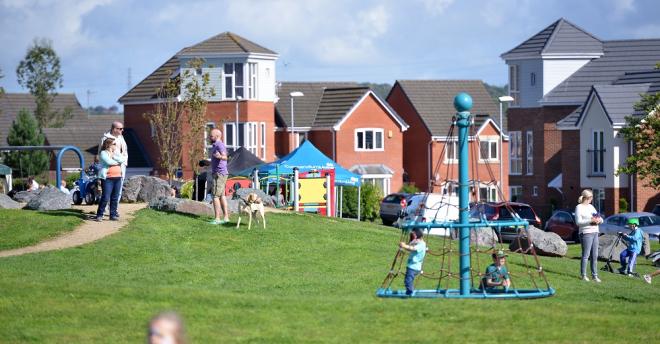













 Completed in 2016, Weston Heights is our award-winning first regeneration project which breathed new life into a once-ailing ex-mining estate in Stoke-on-Trent. Over nearly 10 years the project saw the demolition of 257 obsolete homes. These have been replaced with 280 new homes, in a broad range of housetypes and tenures. The new estate is entirely mixed tenure (and pepper-potted), with about 70% owner-occupation, and 30% affordable rent or low cost home ownership.
Completed in 2016, Weston Heights is our award-winning first regeneration project which breathed new life into a once-ailing ex-mining estate in Stoke-on-Trent. Over nearly 10 years the project saw the demolition of 257 obsolete homes. These have been replaced with 280 new homes, in a broad range of housetypes and tenures. The new estate is entirely mixed tenure (and pepper-potted), with about 70% owner-occupation, and 30% affordable rent or low cost home ownership.
The History
Weston Heights, formerly known as the Coalville estate, is in the Weston Coyney area of Stoke-on-Trent. The National Coal Board (NCB) built the original estate in 1954 to house mining families. However the NCB sold off the homes in the early 1980’s. Some existing residents were able to buy their homes from NCB, but many of the properties went to private landlords. When the non-traditional construction used in the building of the estate was found to be defective, they were deemed unmortgageable.
Although means-tested grants in the 1980s helped some residents to upgrade their homes, many properties remained unmortgageable and continued to appeal largely to private investors. Housing conditions deteriorated significantly over the 1980s & 1990s. This, plus the high proportion of poorly managed private rented homes, led the estate into serious decline and gave it a bad reputation within Stoke-on-Trent. The loss of the mining industry only made things worse, leading to increased unemployment on the estate.
The Transformation Story
After years of campaigning about the estate’s poor housing, poor image and depressed housing market, Coalville Residents Association joined forces with Stoke-on-Trent City Council and registered social landlord Riverside, to form the Coalville Partnership and try to effect change in the area.
The welcome arrival of Housing Market Renewal funding created the opportunity to effect real change in the area. The HMRI body Renew North Staffordshire appointed us to begin the estate’s regeneration in 2006. We joined the Coalville Partnership alongside Riverside, Stoke-on-Trent City Council and the Residents’ Association to effect real change in the area.
The vision was to transform the estate through radical remodelling, to complement surrounding neighbourhoods and countryside. We wanted to turn it back into a place where its founding community are once again proud to live and new families would want to settle. Building work started in January 2007 and the final phase finished in the summer of 2016, culminating with a celebration event on the new park on 11th September 2016.
Engagement with the community was a cornerstone of this project. We consulted them extensively about the masterplan, through open exhibitions, drop-ins, newsletters and detailed home visits. The Residents’ Association was an active member of the Partnership Board and subsequent steering groups. They were involved in all discussions and decisions about the project and the estate management, giving them meaningful input into the project.
Compendium Living also maintained a fully staffed on-site information centre during the first 5 years of the project. This was the period of greatest upheaval, with demolition, re-housing and building taking place. Through this base, our project staff were fully accessible to local people 5 days a week, during this time. We also worked closely with the Residents’ Association to support a variety of community, educational and employment initiatives. Working with them, we helped lever approximately £140k of external funding into the area for socio-economic projects. This brought added benefits to local people, as well as maximising the value of our investment in the estate.
At Weston Heights we also piloted a purchaser-led flexible tenure approach in partnership with housing association Riverside. We earmarked a number of plots for this flexible approach, enabling people to select a home and then choose the right financial and tenure package to suit their circumstances. The Audit Commission highlighted this initiative as ‘Positive practice’ within their 2009 HMR Performance Review.
Most of the sub standard housing has now gone. We have replaced this with a range of well-designed, affordable (private and housing association) and desirable homes. New, attractive recreational spaces were provided. We created a thriving housing market, with a sustainable ratio of homeownership to social housing. In the late 1990s, you could buy a house here for about £12,000; now the average price for a new home is over £150,000. We successfully transformed the area from a run-down, stigmatised estate into a popular community. Together we created a neighbourhood that attracted new households to live alongside original residents in an excellent residential environment.
standard housing has now gone. We have replaced this with a range of well-designed, affordable (private and housing association) and desirable homes. New, attractive recreational spaces were provided. We created a thriving housing market, with a sustainable ratio of homeownership to social housing. In the late 1990s, you could buy a house here for about £12,000; now the average price for a new home is over £150,000. We successfully transformed the area from a run-down, stigmatised estate into a popular community. Together we created a neighbourhood that attracted new households to live alongside original residents in an excellent residential environment.
